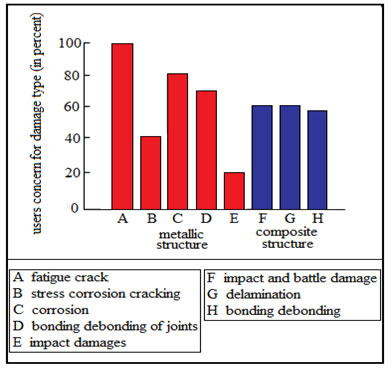Composite structures
Fiber reinforced laminated composites are widely used nowadays in load bearing structures due to their light weight, high specific strength and stiffness, good corrosion resistance and superb fatigue properties. While composites enjoy a number of advantages, they are also prone to wide range of defects and damages which may significantly reduce their structural integrity. Internal damages such as delamination, fiber breakage and matrix cracks are caused easily in the composite laminates under external force such as foreign object collision. Such damages induced by transverse impact can cause reduction in the strength and stiffness of the materials even if the damages are small in size. Hence, there is a need to detect and locate damage as and when it occurs. Figure 10.2 represents the concern of the users for the type of damages in metallic and composite structures which are of their interest.

Figure 10.2 Users concern for the type of damages in metallic and composite structures
The technology for evaluation of metallic structure is fairly mature and most of the present day NDT methods are primarily meant for metallic structures. Damage detection and its evaluation in composites are far more challenging in comparison to the metallic structures due to their micro structural complexities. The anisotropy of composites, conductive nature of some fibers, and brittle nature of matrices make interpretation of data obtained using conventional NDT technique more difficult and sometimes misleading. With more emphasis being given for SHM, these methods are in the process of getting customized to suit the composite structures. |